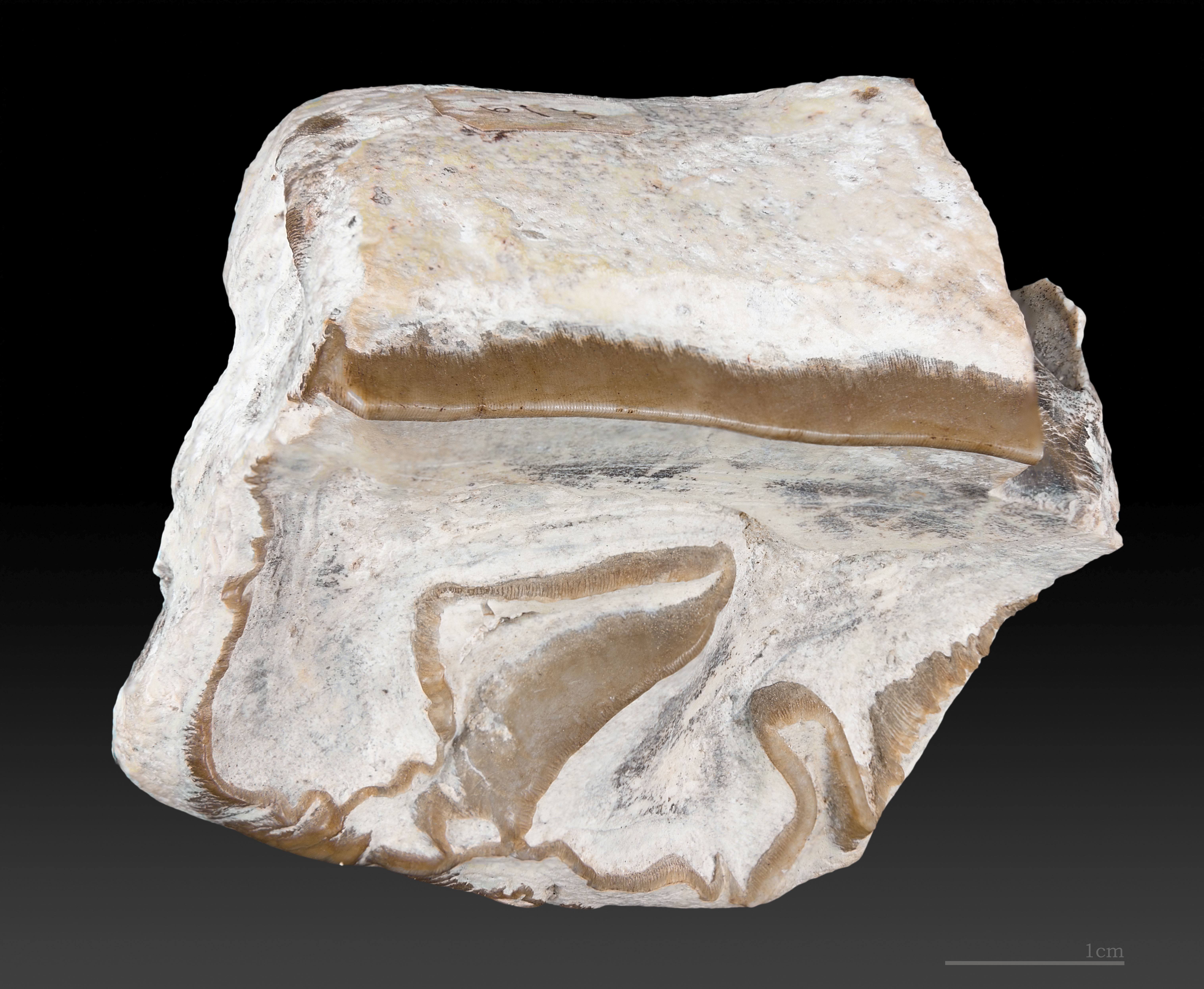|
Foxaspis
''Foxaspis'' (, meaning "fox shield") is a genus of duyunolepidid galeaspid from the early Devonian (Pragian stage) Xiaoshan Formation in Guangxi, Southern China. The type and only species is ''F''. ''novemura'', known from two well-preserved specimens. Discovery and naming ''Foxaspis'' is known from two specimens that were described in 2023 by Gai ''et al''. The holotype, IVPP V30958.1a-b consists of a complete headshield articulated with a body and tail. The paratype, IVPP V30958.2-3, consists of an incomplete headshield and exceptionally preserved tail. The generic name, ''Foxaspis'', is derived from the English word "fox" and the Greek word "aspis", which roughly translates to "shield", meaning the generic name translates to "fox shield". The specific name, ''novemura'', derives from the Latin words "novem", which translates to "nine," and the suffix "-ura" which refers to the tail, meaning the specific name translates to "nine tails". It was named as such after the nin ... [...More Info...] [...Related Items...] OR: [Wikipedia] [Google] [Baidu] |
2023 In Paleoichthyology
This list of fossil fish research presented in 2023 is a list of new fossil taxa of Agnatha, jawless vertebrates, placoderms, Chondrichthyes, cartilaginous fishes, Osteichthyes, bony fishes, and other fishes that were binomial nomenclature, described during the year, as well as other significant discoveries and events related to paleoichthyology that occurred in 2023. Jawless vertebrates Jawless vertebrate research * A study on the anatomy and affinities of ''Lasanius'' is published by Reeves ''et al.'' (2023), who interpret this vertebrate as a Crown group#Stem groups, stem-Cyclostomi, cyclostome. * Dearden ''et al.'' (2023) describe the cranial anatomy of ''Eriptychius, Eriptychius americanus'', provide evidence of the presence of a symmetrical set of cartilages interpreted as the preorbital neurocranium, and report that the studied cartilages filled out the head and closely supported the dermal skeleton (in that they were closer to the cranial anatomy of osteostracans and gal ... [...More Info...] [...Related Items...] OR: [Wikipedia] [Google] [Baidu] |
Galeaspida
Galeaspida (from Latin, 'Helmet shields') is an extinct taxon of jawless marine and freshwater fish. The name is derived from ''galea'', the Latin word for ''helmet'', and refers to their massive bone shield on the head. Galeaspida lived in shallow, fresh water and marine environments during the Silurian and Devonian times (430 to 370 million years ago) in what is now Southern China, Tibet and Vietnam. Superficially, their morphology (biology), morphology appears more similar to that of Heterostraci than Osteostraci, there being currently no evidence that the galeaspids had paired fins. A galeaspid ''Tujiaaspis vividus'' from the Silurian period of China was described in 2022 as having a precursor condition to the form of paired fins seen in Osteostraci and gnathostomes. Earlier than this, Galeaspida were already in fact regarded as being more closely related to Osteostraci, based on the closer similarity of the morphology of the braincase. Morphology The defining characterist ... [...More Info...] [...Related Items...] OR: [Wikipedia] [Google] [Baidu] |
Greek Language
Greek (, ; , ) is an Indo-European languages, Indo-European language, constituting an independent Hellenic languages, Hellenic branch within the Indo-European language family. It is native to Greece, Cyprus, Italy (in Calabria and Salento), southern Albania, and other regions of the Balkans, Caucasus, the Black Sea coast, Asia Minor, and the Eastern Mediterranean. It has the list of languages by first written accounts, longest documented history of any Indo-European language, spanning at least 3,400 years of written records. Its writing system is the Greek alphabet, which has been used for approximately 2,800 years; previously, Greek was recorded in writing systems such as Linear B and the Cypriot syllabary. The Greek language holds a very important place in the history of the Western world. Beginning with the epics of Homer, ancient Greek literature includes many works of lasting importance in the European canon. Greek is also the language in which many of the foundational texts ... [...More Info...] [...Related Items...] OR: [Wikipedia] [Google] [Baidu] |
Tujiaaspis
''Tujiaaspis'' is an extinct genus of eugaleaspidiform that lived during the Telychian stage of the Llandovery epoch. Distribution ''Tujiaaspis vividus'' is known from the Huixingshao Formation of China China, officially the People's Republic of China (PRC), is a country in East Asia. With population of China, a population exceeding 1.4 billion, it is the list of countries by population (United Nations), second-most populous country after .... References {{Taxonbar, from=Q123471046 Fossils of China Fossil taxa described in 2022 Galeaspida Prehistoric jawless fish genera ... [...More Info...] [...Related Items...] OR: [Wikipedia] [Google] [Baidu] |
Classic Of Mountains And Seas
The ''Classic of Mountains and Seas'', also known as ''Shanhai jing'' (), formerly romanized as the ''Shan-hai Ching'', is a Chinese classic text and a compilation of mythic geography and beasts. Early versions of the text may have existed since the 4th century BCE, but the present form was not reached until the early Han dynasty. It is largely a fabulous geographical and cultural account of pre- Qin China as well as a collection of Chinese mythology. The book is divided into eighteen sections; it describes over 550 mountains and 300 channels. Authorship Since Sima Qian, the debate about the author(s) of the book has been going on for more than two thousand years. Definite references Yu the Great and Boyi The earliest records of the ''Classic of Mountains and Seas'' can be found in Sima Qian's "Records of the Grand Historian - Biography of Dawan". The author of the book was first clearly identified in "The table of the Classic Mountains and Seas" written by Liu Xiu in ... [...More Info...] [...Related Items...] OR: [Wikipedia] [Google] [Baidu] |
Nine-tailed Fox
The nine-tailed fox () is a mythical fox entity originating from Chinese mythology. In Chinese folklores, foxes are depicted as spirits possessed of magic powers. These foxes are often depicted as mischievous, usually tricking other people, with the ability to disguise themselves as a beautiful man or woman. Origin The earliest mention of the nine-tailed fox is the ''Shanhaijing'' (''Classic of Mountains and Seas''), compiled from the Warring States period (475 BC–221 BC) to the Western Han (202 BC – 9 AD; 25 AD –220 AD) period. The work states: In chapter 14 of the ''Shanhaijing'', Guo Pu had commented that the nine-tailed fox was an auspicious omen that appeared during times of peace. However, in chapter 1, another aspect of the nine-tailed fox is described: In one ancient myth, Yu the Great encountered a white nine-tailed fox, which he interpreted as an auspicious sign that he would marry Nüjiao. In Han iconography, the nine-tailed fox is sometimes depi ... [...More Info...] [...Related Items...] OR: [Wikipedia] [Google] [Baidu] |
Latin
Latin ( or ) is a classical language belonging to the Italic languages, Italic branch of the Indo-European languages. Latin was originally spoken by the Latins (Italic tribe), Latins in Latium (now known as Lazio), the lower Tiber area around Rome, Italy. Through the expansion of the Roman Republic, it became the dominant language in the Italian Peninsula and subsequently throughout the Roman Empire. It has greatly influenced many languages, Latin influence in English, including English, having contributed List of Latin words with English derivatives, many words to the English lexicon, particularly after the Christianity in Anglo-Saxon England, Christianization of the Anglo-Saxons and the Norman Conquest. Latin Root (linguistics), roots appear frequently in the technical vocabulary used by fields such as theology, List of Latin and Greek words commonly used in systematic names, the sciences, List of medical roots, suffixes and prefixes, medicine, and List of Latin legal terms ... [...More Info...] [...Related Items...] OR: [Wikipedia] [Google] [Baidu] |
Devonian
The Devonian ( ) is a period (geology), geologic period and system (stratigraphy), system of the Paleozoic era (geology), era during the Phanerozoic eon (geology), eon, spanning 60.3 million years from the end of the preceding Silurian period at million years ago (Megaannum, Ma), to the beginning of the succeeding Carboniferous period at Ma. It is the fourth period of both the Paleozoic and the Phanerozoic. It is named after Devon, South West England, where rocks from this period were first studied. The first significant evolutionary radiation of history of life#Colonization of land, life on land occurred during the Devonian, as free-spore, sporing land plants (pteridophytes) began to spread across dry land, forming extensive coal forests which covered the continents. By the middle of the Devonian, several groups of vascular plants had evolved leaf, leaves and true roots, and by the end of the period the first seed-bearing plants (Pteridospermatophyta, pteridospermatophyt ... [...More Info...] [...Related Items...] OR: [Wikipedia] [Google] [Baidu] |
Paratype
In zoology and botany, a paratype is a specimen of an organism that helps define what the scientific name of a species and other taxon actually represents, but it is not the holotype (and in botany is also neither an isotype (biology), isotype nor a syntype). Often there is more than one paratype. Paratypes are usually held in museum research collections. The exact meaning of the term ''paratype'' when it is used in zoology is not the same as the meaning when it is used in botany. In both cases however, this term is used in conjunction with ''holotype''. Zoology In zoological nomenclature, a paratype is officially defined as "Each specimen of a type series other than the holotype.", ''International Code of Zoological Nomenclature'' In turn, this definition relies on the definition of a "type series". A type series is the material (specimens of organisms) that was cited in the original publication of the new species or subspecies, and was not excluded from being type material ... [...More Info...] [...Related Items...] OR: [Wikipedia] [Google] [Baidu] |
Pragian
The Pragian is one of three faunal stages in the Early Devonian Epoch. It lasted from 410.8 ± 2.8 million years ago to 407.6 ± 2.8 million years ago. It was preceded by the Lochkovian Stage and followed by the Emsian Stage. The most important Lagerstätte of the Pragian is Rhynie chert in Scotland. It is named after the city of Prague Prague ( ; ) is the capital and List of cities and towns in the Czech Republic, largest city of the Czech Republic and the historical capital of Bohemia. Prague, located on the Vltava River, has a population of about 1.4 million, while its P .... The GSSP is located within the Prague Formation at Velká Chuchle, Prague. In North America the Pragian Stage is represented by Siegenian or Deerparkian time. Pragian life The first ammonoids (order Agoniatitida) appeared in later parts of this stage (at the lower boundary of the Zlichovian stage as it was known in Siberian representations). They were descended from bactritoid nautiloi ... [...More Info...] [...Related Items...] OR: [Wikipedia] [Google] [Baidu] |





